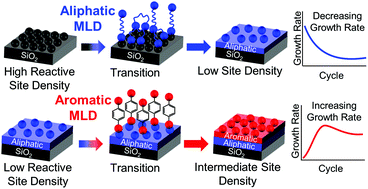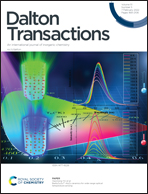In situ analysis of growth rate evolution during molecular layer deposition of ultra-thin polyurea films using aliphatic and aromatic precursors†
Abstract
Organic thin films formed by molecular layer deposition (MLD) are important for next-generation electronics, energy storage, photoresists, protective barriers and other applications. This study uses in situ ellipsometry and quartz crystal microbalance to explore growth initiation and growth rate evolution during MLD of polyurea using aromatic p-phenylene diisocyanate (PDIC) or aliphatic 1,6-hexamethylene diisocyanate (HDIC) combined with ethylenediamine (ED) or 1,6-hexanediamine (HD) co-reactants. During the first 10–20 cycles of growth, we show the growth rate can increase and/or decrease substantially depending on the substrate as well as the flexibility, length, and structure of the isocyanate and amine reactants used. The transition from initial to steady growth is attributed to a change in active surface site density as the growth proceeds, where the number of sites is determined by a balance between steric effects that block active sites, double reactions that consume multiple active sites, and precursor physisorption and sub-surface diffusion that create new active sites, where the extent of each mechanism depends on the precursors and deposition conditions. Results shown here provide useful insight into mechanisms needed to control growth of ultra-thin organic films for advanced applications.

- This article is part of the themed collection: Spotlight Collection: Atomic and Molecular Layer Deposition


 Please wait while we load your content...
Please wait while we load your content...
